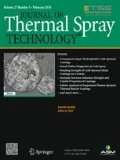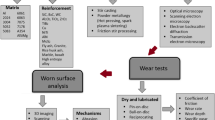Abstract
Abradable coatings are used in gas turbines to minimize the clearance distance between the stationary components and rotating blade tips. In this study, the effect of microstructure refining on the properties of abradable AlSi-polyester coatings was investigated. The coatings were deposited by conventional atmospheric plasma spraying system (APS) and high efficiency supersonic atmospheric plasma spraying system (SAPS). The results showed that the average area of single polyester phase was 351 ± 27 µm2 in SAPS coating, about 25.2% lower than that of APS coating (469 ± 22 µm2). The hardness and bonding strength of as-sprayed SAPS coating were 79 HR15Y and 15.2 MPa, respectively, about 16.2 and 28.8% higher than the hardness and bonding strength of as-sprayed APS coating (68 HR15Y and 11.8 MPa). The track depth and friction coefficient of SAPS coating were about 51.1 and 16.9% lower than those of APS coating. When the coatings were subjected to hot-corrosion and thermal shock tests, the hardness and bonding strength of SAPS coating (47 HR15Y and 6.3 MPa) were about 67.9 and 200% higher than those of APS coating (28 HR15Y and 2.1 MPa). Additionally, the track depth and friction coefficient of SAPS coating were about 61.3 and 12.1% lower than those of APS coating. This work shows that the refinement of polyester phase, low porosity and less amount of Si phase precipitation were beneficial to improve the thermal stability and in-service performance of the abradable AlSi-polyester coatings.











Similar content being viewed by others
References
A. Pellegrino, P.M. Maria Jesus, K. Dragnevski, G. Zumpano and N. Petrinic, Temperature and Strain Rate Dependent Mechanical Response of METCO 601 Aluminium-Polyester Abradable Seal Coating, EPJ Web Conf., 2018, 183(04012), p 1–6.
D. Jech, L. Čelko, P. Komarov, J. Ziegelheim, Z. Česánek and J. Schubert, The Role of Different Atmospheric Plasma Spray Parameters on Microstructure of Abradable AlSi-Polyester Coatings, Solid State Phenom., 2017, 270, p 224–229.
H.J. Xuan, N. Zhang, Y.Q. Hu, J. Shen and W.R. Hong, Evaluation of an AlSi-Polyester Abradable Seal Coating Performance Using High-Temperature and High-Velocity Abrasion Tests, Proc. Ins. Mech. Eng. J-J Eng. Tribol., 2015, 230, p 842–851.
S. Gao, W. Xue, D. Duan, S. Li and H. Zheng, Effect of Thermal—Physical Properties on the Abradability of Seal Coating Under High-Speed Rubbing Condition, Wear, 2018, 394–395, p 20–29.
M.Z. Yi, B.Y. Huang and J.W. He, Erosion Wear Behaviour and Model of Abradable Seal Coating, Wear, 2002, 252, p 9–15.
M. Öksüz and H. Yıldırım, Structure and Properties of AlSi/Polyester Coating, J. Appl. Polym. Sci., 2004, 93, p 2437–2444.
R. Rajendran, Gas Turbine Coatings—An Overview, Eng. Fail. Anal., 2012, 26, p 355–369.
Y.M. Guo, S. Zhu, Z.Y. Song, Q.G. Yu, M. Wei and J. Chen, Microstruture and Friction Behavior of AlSi/Polyester Composited Coating Prepared by Subsonic Flame Spraying, China Surf. Eng., 2017, 29, p 85–90. (in Chinese)
T.T. Cheng, K.Y. Ding, Z.H. Ji and Z.P. Wang, Effect of Thermal Aging on Sand Erosion Resistance of AlSi Polyphony Ester Coating, T. Mater. Heat Treat., 2017, 38, p 148–154. (in Chinese)
Y. Duramou, R. Bolot, J.L. Seichepine, Y. Danlos, P. Bertrand, G. Montavon and S. Selezneff, Relationships between Microstructural and Mechanical Properties of Plasma Sprayed AlSi-Polyester Composite Coatings: Application to Abradable Materials, Key Eng. Mater., 2014, 606, p 155–158.
J.J. Tang, K. Liu, Q.Z. Yang, Y.H. Wang, P. Zhang, Y. Wang, L. Zhao, Q.Q. Fu, Z.H. Han and Y. Bai, The Influence of Size and Distribution of Graphite on the Friction and Wear Behavior of Ni-Graphite Coatings, Surf. Coat. Technol., 2014, 252, p 48–55.
C.H. Ding, C.H. Liu, Z.M. Yang, Y.P. Wang, Z.B. Sun and L. Yu, Effect of Size Refinement and Distribution of Lubricants on Friction Coefficient of High Temperature Self-Lubricating Composites, Compos. Sci. Technol., 2010, 70, p 1000–1005.
M. Yi, J. He, B. Huang and H. Zhou, Friction and Wear Behaviour and Abradability of Abradable Seal Coating, Wear, 1999, 231, p 47–53.
Y. Bai, L. Zhao, K. Liu, J.J. Tang and Z.H. Han, Fine-Lamellar Structured Thermal Barrier Coatings Fabricated by High Efficiency Supersonic Atmospheric Plasma Spraying, Vacuum, 2014, 99, p 119–123.
Y. Bai, Z.H. Han, H.Q. Li, C. Xu, Y.L. Xu, C.H. Ding and J.F. Yang, Structure—Property Differences Between Supersonic and Conventional Atmospheric Plasma Sprayed Zirconia Thermal Barrier Coatings, Surf. Coat. Technol., 2011, 205, p 3833–3839.
C. Cui, A. Schulz, K. Schimanski and H.W. Zoch, Spray Forming of Hypereutectic Al-Si Alloys, J. Mater. Process. Technol., 2009, 209, p 5220–5228.
X.W. Zhu, R.C. Wang, C.Q. Peng and J. Peng, Microstructure and Thermal Expansion Behavior of Hypereutectic Al-Si Alloy, J. Cent. South Univ., 2016, 47, p 1500–1505.
Acknowledgments
This work was supported by the Natural Science Basic Research Plan in Shaanxi Province of China (Grant No. 2020JQ-911, 2020JM-631, 2019JQ-910), and Natural Science Foundation of China (Grant No.51902241).
Author information
Authors and Affiliations
Corresponding author
Additional information
Publisher's Note
Springer Nature remains neutral with regard to jurisdictional claims in published maps and institutional affiliations.
Rights and permissions
About this article
Cite this article
Tang, Jj., Yu, Fl., Zhang, Hh. et al. Effect of Microstructure Refining on the Thermal Stability and Wear Resistance of Abradable AlSi-Polyester Coating. J Therm Spray Tech 30, 1615–1623 (2021). https://doi.org/10.1007/s11666-021-01217-8
Received:
Revised:
Accepted:
Published:
Issue Date:
DOI: https://doi.org/10.1007/s11666-021-01217-8




